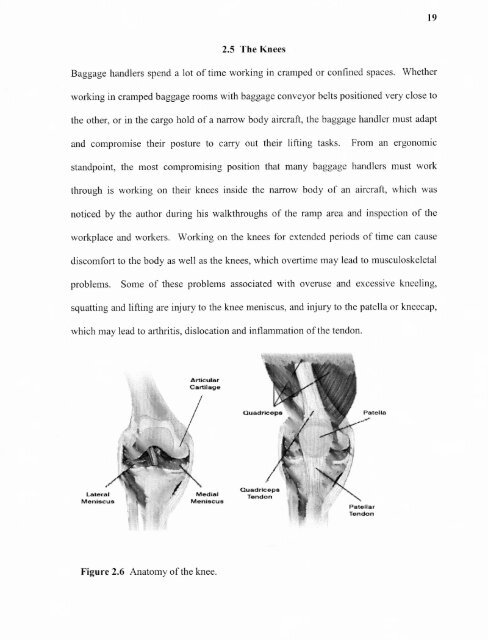An ergonomic assessment of the airline baggage handler
An ergonomic assessment of the airline baggage handler An ergonomic assessment of the airline baggage handler
192.5 The KneesBaggage handlers spend a lot of time working in cramped or confined spaces. Whetherworking in cramped baggage rooms with baggage conveyor belts positioned very close tothe other, or in the cargo hold of a narrow body aircraft, the baggage handler must adaptand compromise their posture to carry out their lifting tasks. From an ergonomicstandpoint, the most compromising position that many baggage handlers must workthrough is working on their knees inside the narrow body of an aircraft, which wasnoticed by the author during his walkthroughs of the ramp area and inspection of theworkplace and workers. Working on the knees for extended periods of time can causediscomfort to the body as well as the knees, which overtime may lead to musculoskeletalproblems. Some of these problems associated with overuse and excessive kneeling,squatting and lifting are injury to the knee meniscus, and injury to the patella or kneecap,which may lead to arthritis, dislocation and inflammation of the tendon.Figure 2.6 Anatomy of the knee.
CHAPTER 3LITERATURE REVIEWS3.1 Summation of Core ArticlesA literature search for ergonomic research and scientific reviews on baggage handlerswas performed. To the author's surprise, there were not many journal articles availablethat focused on baggage handlers and the ergonomic aspects of this work group.Literature review revealed that most articles referred back to a few articles written byGeoff Dell (Dell, 1997, 1998a, 1998b) in the late 90's. Dell wrote two main articles,which served as the basis for the many subsequent articles on baggage handlers, andergonomics, all of which referenced Dell. These two articles are "The Causes andPrevention of Baggage Handler Back Injuries: A Survey of Airline Safety ProfessionalsAirline Baggage Handler Back Injuries Vol 1 ; and "Airline Baggage Handler BackInjuries: A Survey of Baggage Handlers Opinion on Causes and Prevention Volt."Other articles that focused on the baggage conveyor systems were, "Postural strain anddiscomfort during loading and unloading flights: an Ergonomic Intervention study, andBaggage handling postures and the design of conveyors" by Thomas et al. (1995). I alsoreviewed investigations pertaining to baggage handlers and the use of back supports beltsof which were: "An evaluation of a weightlifting belt and back injury prevention trainingclass for airline baggage handlers" by Reddell et al. (1992), and "Effects of industrialback supports on physiological demand, lifting style and perceived exertion" byJorgensen et al. (1987). Furthermore, a few more articles that were non-specific tobaggage handlers that focused on back belts, lifting postures and applied lifting forces in20
- Page 5: AN ERGONOMIC ASSESSMENTOF THE AIRLI
- Page 8 and 9: BIOGRAPHICAL SKETCHAuthor: Stephen
- Page 10 and 11: ACKNOWLEDGMENTI would like to expre
- Page 12 and 13: TABLE OF CONTENTS(Continued)Chapter
- Page 14 and 15: CHAPTER 1INTRODUCTION1.1 Baggage Ha
- Page 16 and 17: 31.2.2 Author's PreparationMany tim
- Page 18 and 19: 5way in and out of the work area. T
- Page 20: 71.3.4.4 Evidence of No Effect of W
- Page 23 and 24: Figure 2.1 Principle muscle groups
- Page 25 and 26: 12vertebrae are aligned, their cent
- Page 27 and 28: 14which obesity, poor conditioning,
- Page 29 and 30: Figure 2.4 Musculature of the Later
- Page 31: Figure 2.5 Anatomy of the Shoulder
- Page 35 and 36: 22loading and unloading of narrow-b
- Page 37 and 38: 24When the safety professionals wer
- Page 39 and 40: 26exceeded 70lbs (32kg). However, 1
- Page 41: 28slowing changing along the landsc
- Page 44 and 45: 31aircraft on the tarmac, the bagga
- Page 46 and 47: 33baggage handlers with 111 (71%) p
- Page 48 and 49: 35In response to the training quest
- Page 50 and 51: 37question about loading the wide b
- Page 52 and 53: 39combinations were calculated. Eac
- Page 54 and 55: 41participants from the Royal Dutch
- Page 56 and 57: 43The heights, angles, and velociti
- Page 58 and 59: 45placed on various joints on the b
- Page 60 and 61: 47The purpose of introducing the pi
- Page 62 and 63: 493.6 Back Belt LiteratureThe notio
- Page 64 and 65: 51It was out of this necessity for
- Page 66 and 67: 53The fleet service clerks, or bagg
- Page 68 and 69: 55increase in TAP can increase the
- Page 70 and 71: 57A concern for this study is the m
- Page 72 and 73: 59A body chart diagram to assess wo
- Page 74 and 75: 615.2 The Future of Baggage Handlin
- Page 76 and 77: 635.2.1 Workstation RedesignThe wor
- Page 78 and 79: 65injury because the top and lower
- Page 80 and 81: 67baggage handlers as well as aviat
192.5 The KneesBaggage <strong>handler</strong>s spend a lot <strong>of</strong> time working in cramped or confined spaces. Whe<strong>the</strong>rworking in cramped <strong>baggage</strong> rooms with <strong>baggage</strong> conveyor belts positioned very close to<strong>the</strong> o<strong>the</strong>r, or in <strong>the</strong> cargo hold <strong>of</strong> a narrow body aircraft, <strong>the</strong> <strong>baggage</strong> <strong>handler</strong> must adaptand compromise <strong>the</strong>ir posture to carry out <strong>the</strong>ir lifting tasks. From an <strong>ergonomic</strong>standpoint, <strong>the</strong> most compromising position that many <strong>baggage</strong> <strong>handler</strong>s must workthrough is working on <strong>the</strong>ir knees inside <strong>the</strong> narrow body <strong>of</strong> an aircraft, which wasnoticed by <strong>the</strong> author during his walkthroughs <strong>of</strong> <strong>the</strong> ramp area and inspection <strong>of</strong> <strong>the</strong>workplace and workers. Working on <strong>the</strong> knees for extended periods <strong>of</strong> time can causediscomfort to <strong>the</strong> body as well as <strong>the</strong> knees, which overtime may lead to musculoskeletalproblems. Some <strong>of</strong> <strong>the</strong>se problems associated with overuse and excessive kneeling,squatting and lifting are injury to <strong>the</strong> knee meniscus, and injury to <strong>the</strong> patella or kneecap,which may lead to arthritis, dislocation and inflammation <strong>of</strong> <strong>the</strong> tendon.Figure 2.6 <strong>An</strong>atomy <strong>of</strong> <strong>the</strong> knee.



